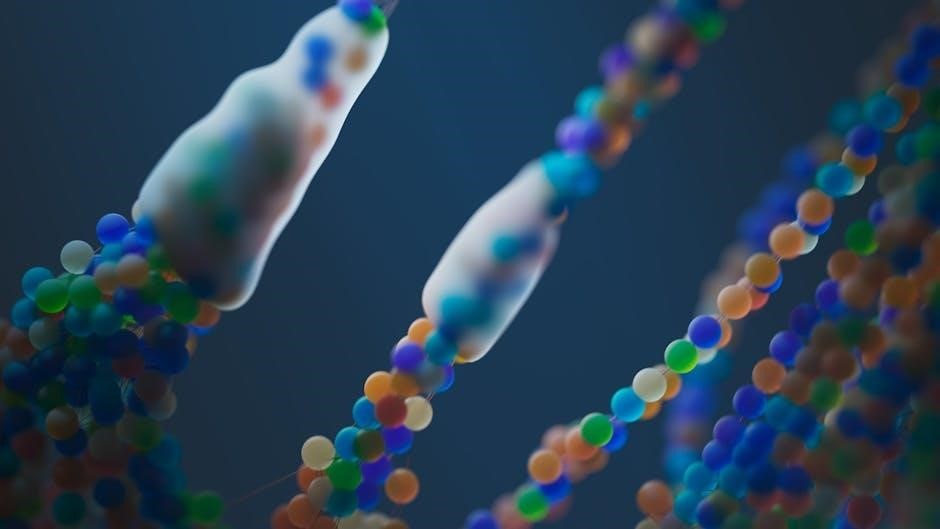Organic chemistry lab is a hands-on environment where students master techniques, safety protocols, and instrumentation. The Organic Chemistry Lab Survival Manual by James Zubrick is a key resource, offering practical guidance on lab safety, instrumentation, and essential techniques. It emphasizes understanding laboratory practices, interpreting data, and developing problem-solving skills. This section introduces the fundamentals of organic chemistry lab, preparing students for successful experimentation and analysis.
1.1 Importance of Organic Chemistry in Modern Science
Organic chemistry plays a vital role in advancing modern science, particularly in understanding biomolecules, developing new materials, and environmental protection. It underpins biotechnology, pharmaceuticals, and materials science, enabling the creation of life-saving drugs and sustainable solutions. The Organic Chemistry Lab Survival Manual highlights these applications, emphasizing how mastering lab techniques and safety fosters innovation. This field’s relevance is undeniable, driving progress in diverse scientific domains and addressing global challenges effectively.
1.2 Overview of Lab Safety and Etiquette
Laboratory safety is paramount in organic chemistry, requiring strict adherence to protocols. Proper handling of hazardous chemicals, mandatory use of PPE, and understanding emergency procedures are essential. Students must stay organized, maintain a clean workspace, and follow lab rules to ensure a safe environment. Collaboration and respect for shared spaces foster a productive and secure atmosphere, minimizing risks and promoting efficient experimentation. This section underscores the importance of preparedness and decorum in the lab setting.

Essential Lab Skills for Success
Mastering accurate measurements, precise techniques, and efficient time management are critical for success in organic chemistry lab. Developing these skills ensures reliable results and safe practices.
2.1 Basic Techniques in Organic Chemistry Lab
Mastering essential techniques like distillation, filtration, and chromatography is fundamental for organic chemistry lab success. These methods ensure effective purification and separation of compounds. Proper handling of glassware, such as burettes and pipettes, is also crucial. Understanding solvent extraction and crystallization enhances purity control. Safety practices, including handling hazardous chemicals and using personal protective equipment, are emphasized. Proficiency in these techniques builds a strong foundation for conducting experiments accurately and safely, as outlined in the Organic Chemistry Lab Survival Manual.
2.2 Understanding Lab Equipment and Instruments
Understanding lab equipment is crucial for conducting experiments safely and efficiently. Essential tools include glassware like burettes, pipettes, and flasks, as well as instruments such as IR and NMR spectroscopes. The Organic Chemistry Lab Survival Manual provides detailed guidance on operating and maintaining this equipment. Proper use ensures accurate results and minimizes risks. Familiarity with instruments enhances experimental design and data interpretation, making it a cornerstone of successful organic chemistry lab work.
2;3 Effective Record-Keeping and Data Management
Accurate and organized record-keeping is vital in organic chemistry lab. Maintain a detailed lab notebook with observations, calculations, and conclusions. Use standardized methods for data collection and analysis. Label and date all entries clearly. Digital tools can enhance organization, but ensure backups are made. Proper documentation ensures reproducibility and facilitates troubleshooting. The Organic Chemistry Lab Survival Manual emphasizes the importance of clear, precise records for successful experimental outcomes and efficient data management.

Safety Protocols and Precautions
Safety is paramount in organic chemistry lab. Proper handling of hazardous chemicals, use of PPE, and adherence to emergency procedures are essential. The Organic Chemistry Lab Survival Manual provides detailed guidelines to ensure a safe working environment and prevent accidents.
3.1 Handling Hazardous Chemicals Safely
Handling hazardous chemicals requires careful attention to safety protocols. Always read labels, use appropriate PPE, and follow proper handling techniques. Store chemicals in designated areas and dispose of waste according to lab guidelines. Understanding chemical properties and reactivity is crucial to prevent accidents. Refer to the Organic Chemistry Lab Survival Manual for detailed safety procedures and emergency response plans. Proper training and adherence to safety measures ensure a secure lab environment for all personnel.
3.2 Proper Use of Personal Protective Equipment (PPE)
Proper use of PPE is essential in organic chemistry labs to minimize exposure to hazardous substances. Always wear gloves, goggles, and lab coats when handling chemicals. Face shields or masks may be required for high-risk procedures. Ensure PPE fits correctly and is free from defects. Remove PPE before leaving the lab and dispose of it properly. Refer to the Organic Chemistry Lab Survival Manual for detailed guidelines on selecting and using appropriate PPE for specific tasks.
3.3 Emergency Procedures in the Lab
In case of emergencies, stay calm and follow established protocols. Familiarize yourself with exit routes, fire extinguishers, and emergency showers. For chemical spills, contain the area and use absorbent materials. In case of fires, evacuate and alert others. For injuries, provide first aid and seek medical help immediately. Regular drills and training ensure preparedness. Always refer to the Organic Chemistry Lab Survival Manual for detailed guidance on handling emergencies effectively and safely.
Common Lab Equipment and Their Uses
Essential lab equipment includes burettes, pipettes, beakers, flasks, and glassware. These tools are used for measuring, mixing, heating, and storing chemicals. Understanding their functions enhances accuracy and safety, ensuring smooth lab operations and minimizing hazards. Proper use of equipment is crucial for successful organic chemistry experiments and maintaining a safe working environment.
4.1 Understanding Glassware and Apparatus
Glassware and apparatus in organic chemistry labs include round-bottom flasks, Erlenmeyer flasks, and burettes. These tools are used for mixing, heating, and measuring liquids. Proper identification and handling ensure accurate experiments and safety. For instance, round-bottom flasks are ideal for reflux setups, while Erlenmeyer flasks are suited for mixing and stirring. Understanding their roles and care is vital for maintaining lab efficiency and preventing accidents. Always inspect glassware for cracks or damage before use to avoid breakage during procedures.
4.2 Operation and Maintenance of Lab Instruments
Understanding the operation and maintenance of lab instruments is crucial for accurate results and safety. Instruments like spectrophotometers and chromatography systems require proper calibration and handling. Regular maintenance ensures optimal performance and longevity. Always follow manufacturer guidelines and lab protocols for operation. Cleaning and storing instruments correctly prevents damage and contamination. Familiarize yourself with user manuals and seek guidance from experienced staff to ensure proficiency. Proper instrument care is essential for reliable data and a smooth lab experience.
4.3 Essential Tools for Organic Synthesis
Essential tools for organic synthesis include glassware like round-bottom flasks, condensers, and separatory funnels. Instruments such as rotary evaporators and chromatography columns are vital for purification. Syringes, needles, and cannulas are used for transferring liquids under inert atmospheres. These tools enable precise control over reactions, ensuring efficient synthesis and purification. Understanding their proper use is critical for achieving high yields and purity in organic compounds. Regular maintenance and calibration of equipment are also key to successful experiments.

Key Techniques in Organic Chemistry Lab
Mastering techniques like distillation, chromatography, and crystallization is fundamental for purification and separation in organic chemistry. These methods ensure purity and efficiency in synthesizing compounds, essential for successful lab work.
5.1 Distillation and Purification Methods
Distillation is a critical purification technique in organic chemistry, separating compounds based on boiling points. The Organic Chemistry Lab Survival Manual highlights fractional distillation for isolating pure substances. Proper setup and careful monitoring ensure effective separation. Additionally, crystallization and chromatography are key purification methods, enabling researchers to obtain high-purity compounds. These techniques are essential for synthesizing and analyzing organic molecules, ensuring accuracy in experiments and reliable results.
5.2 Chromatography and Separation Techniques
Chromatography is a versatile method for separating organic compounds based on their interactions with a stationary phase. The Organic Chemistry Lab Survival Manual outlines techniques like column chromatography and thin-layer chromatography (TLC). These methods are essential for purifying substances and analyzing mixtures. TLC is particularly useful for monitoring reaction progress and identifying impurities. Mastering chromatography enhances lab efficiency and ensures accurate results in organic synthesis and purification processes.
5.3 Crystallization and Recrystallization
Crystallization and recrystallization are essential techniques for purifying organic compounds. The Organic Chemistry Lab Survival Manual provides detailed guidance on these methods. Crystallization involves dissolving a compound in a hot solvent and allowing it to cool, enabling pure crystals to form. Recrystallization refines purity further by repeating the process. Proper solvent selection, cooling rates, and avoiding impurities are critical for success. These techniques are fundamental for obtaining high-purity products in organic synthesis and analysis.

Analytical Methods in Organic Chemistry
Analytical methods in organic chemistry involve techniques like spectroscopy (IR, NMR, UV-Vis) and mass spectrometry to identify and verify compound structures. These tools are crucial for accurate analysis and characterization, enabling students to confirm reaction outcomes and purity in laboratory experiments.
Spectroscopy is a cornerstone of organic chemistry, enabling the identification and analysis of molecular structures. Infrared (IR) spectroscopy identifies functional groups by absorbing specific wavelengths. Nuclear Magnetic Resonance (NMR) provides detailed information about molecular environments and bonding. Ultraviolet-Visible (UV-Vis) spectroscopy measures electronic transitions, useful for conjugated systems. These techniques, covered in the Organic Chemistry Lab Survival Manual, are essential for verifying compound identity, purity, and structural features, making them indispensable tools in the organic chemistry laboratory.
6.2 Interpreting Spectral Data for Structural Analysis
Interpreting spectral data is crucial for determining molecular structures. IR spectroscopy identifies functional groups based on absorption peaks, such as carbonyl groups near 1700 cm⁻¹; NMR spectroscopy provides details about hydrogen environments, with chemical shifts and splitting patterns aiding in structural elucidation. UV-Vis spectroscopy reveals electronic transitions, useful for conjugated systems. By correlating data from these techniques, chemists can deduce molecular structures effectively. The Organic Chemistry Lab Survival Manual offers guidance on integrating and interpreting spectral data for accurate structural analysis.
6.3 Mass Spectrometry and Its Applications
Mass spectrometry is a powerful analytical tool for determining molecular weight and identifying compounds. It works by ionizing molecules and measuring their mass-to-charge ratio, providing structural insights through fragmentation patterns. In organic chemistry, it is used to confirm compound identity, detect impurities, and analyze reaction products. The Organic Chemistry Lab Survival Manual highlights its importance in modern labs, offering guidance on interpreting spectra and applying this technique effectively for accurate molecular analysis and purification processes.

Common Organic Reactions and Mechanisms
Common organic reactions and mechanisms are fundamental to synthesis. Key reactions include SN1, SN2, elimination, addition, and oxidation-reduction processes. Understanding these pathways is crucial for predicting reaction outcomes and synthesizing target compounds effectively.
7.1 SN1, SN2, and Elimination Reactions
SN1 and SN2 reactions differ in mechanisms: SN1 involves a carbocation intermediate, while SN2 proceeds via a backside attack. Elimination reactions, like E1 and E2, form alkenes. Understanding reaction conditions and substrate structure is key to controlling outcomes. The Organic Chemistry Lab Survival Manual provides insights into optimizing these reactions, emphasizing solvent, temperature, and reagent selection to maximize yields and minimize by-products.
7.2 Addition Reactions and Stereochemistry
Addition reactions involve the addition of atoms or groups to double or triple bonds, often following specific stereochemical rules. Stereochemistry determines the spatial arrangement of atoms, affecting reaction outcomes. The Organic Chemistry Lab Survival Manual highlights the importance of understanding stereoselectivity and regioselectivity. Factors like reagent type, solvent, and reaction conditions influence stereochemical outcomes. Mastering these concepts is crucial for predicting and controlling reaction pathways, ensuring desired products and minimizing unwanted by-products;
7.3 Oxidation and Reduction Reactions
Oxidation and reduction reactions involve electron transfer, altering the oxidation state of atoms. These reactions are fundamental in organic synthesis, enabling transformations like alcohol oxidation to ketones or aldehydes. Common oxidizing agents include KMnO4 and CrO3, while reducing agents like NaBH4 or LiAlH4 facilitate reductions. Reaction conditions, such as solvent choice and temperature, influence outcomes. Understanding redox mechanisms is vital for controlling reaction pathways and achieving desired products, making these reactions indispensable in organic chemistry lab workflows and industrial applications.

Troubleshooting Common Lab Issues
Troubleshooting in organic chemistry lab involves identifying experimental errors, correcting techniques, and addressing unexpected reactions. The Organic Chemistry Lab Survival Manual provides strategies to minimize side products and improve reaction yields, ensuring successful outcomes through systematic problem-solving and adherence to best practices.
8.1 Identifying and Correcting Experimental Errors
Identifying experimental errors in organic chemistry labs requires careful observation and analysis. Common mistakes include improper glassware setup, inaccurate measurements, and incorrect reagent ratios. The Organic Chemistry Lab Survival Manual highlights the importance of maintaining precise records to trace errors. Techniques such as re-calibrating instruments, double-checking procedures, and consulting lab manuals can help correct issues. Addressing errors promptly ensures accurate results and avoids safety risks, fostering a culture of precision and accountability in the lab environment.
8.2 Managing Unforeseen Reactions and Side Products
Unforeseen reactions and side products can arise due to impurities, incorrect reagent ratios, or unexpected conditions. The Organic Chemistry Lab Survival Manual advises staying vigilant and monitoring reactions closely. Techniques like thin-layer chromatography (TLC) and spectroscopy help identify unexpected compounds. If side products form, isolating and analyzing them can provide insights. Consulting lab manuals or instructors is crucial for troubleshooting. Proper documentation and adaptive strategies ensure experiments remain safe and productive, even when unexpected outcomes occur.
8.3 Strategies for Improving Reaction Yields
Improving reaction yields involves optimizing conditions, monitoring progress, and minimizing losses. Techniques like thin-layer chromatography (TLC) help track reaction completion. Controlling temperature, time, and stoichiometry ensures efficiency. Using anhydrous solvents and excess reagents can enhance yields. Post-reaction purification methods, such as crystallization or distillation, further refine products. The Organic Chemistry Lab Survival Manual emphasizes these strategies to maximize efficiency and achieve higher purity in experimental outcomes, ensuring successful and reproducible results.

Time Management and Organization in the Lab
Efficient time management and organization are crucial for success in the organic chemistry lab. The Organic Chemistry Lab Survival Manual offers practical tips on prioritizing tasks and maintaining a clean workspace to optimize productivity and reduce errors.
9.1 Prioritizing Tasks and Meeting Deadlines
Effective task prioritization is essential for meeting deadlines in the organic chemistry lab. The Organic Chemistry Lab Survival Manual emphasizes understanding task urgency and complexity. Start with critical procedures, allocate time wisely, and minimize distractions. Breaking tasks into manageable steps ensures steady progress. Maintain a structured schedule and use tools like checklists or digital apps to track deadlines. Proper organization and time management enhance productivity and reduce stress, making lab work more efficient and enjoyable. Prioritizing tasks ensures timely completion of experiments and data analysis.
9.2 Staying Organized During Complex Syntheses
Staying organized during complex syntheses is crucial for success in organic chemistry lab. Use detailed checklists and flowcharts to track reactions and steps. Label all samples and reagents clearly to avoid mix-ups. Maintain a clean workspace to prevent contamination and errors. Utilize digital tools or lab notebooks for documenting progress. Prioritize tasks based on reaction times and dependencies. Regularly review procedures to ensure alignment with experimental goals. Proper organization enhances efficiency, reduces errors, and streamlines complex syntheses.
9.3 Effective Collaboration with Lab Partners
Effective collaboration with lab partners is vital for success in organic chemistry lab. Communicate clearly about roles, responsibilities, and expectations. Establish a plan for dividing tasks and monitoring progress. Share insights and ideas to troubleshoot challenges together. Maintain mutual respect and patience, as teamwork enhances problem-solving and efficiency. Regularly review and discuss results to ensure alignment. A strong partnership fosters a productive and positive lab environment, leading to better outcomes and a deeper understanding of complex syntheses.

Resources for Learning and Reference
Key resources include the Organic Chemistry Lab Survival Manual by James Zubrick, offering practical guidance. Additional materials like The Organic Chemistry of Drug Synthesis and the CRC Handbook of Chemistry and Physics provide comprehensive support; Online tutorials and lab manuals also serve as valuable references for mastering techniques and understanding complex concepts in organic chemistry.
10.1 Recommended Textbooks and Manuals
Essential textbooks include The Organic Chemistry Lab Survival Manual by James Zubrick, offering hands-on guidance for lab techniques and safety. The Organic Chemistry of Drug Synthesis provides insights into pharmaceutical chemistry, while the CRC Handbook of Chemistry and Physics serves as a comprehensive reference. These resources are indispensable for understanding instrumentation, interpreting data, and mastering organic chemistry principles. They complement lab manuals and online tutorials, ensuring a well-rounded learning experience.
10.2 Online Resources and Tutorials
Online resources like Khan Academy, Coursera, and YouTube offer tutorials on organic chemistry techniques. Websites such as LabX and ScienceDirect provide access to lab manuals and research articles. The Organic Chemistry Lab Survival Manual companion website offers additional guides and practice problems. These resources enhance understanding of lab procedures, safety protocols, and data interpretation, making them invaluable for students seeking supplementary learning materials and hands-on practice opportunities.
10.3 Seeking Help from Instructors and Peers
Seeking guidance from instructors and peers is crucial for success in organic chemistry lab. Instructors can provide expert insights, clarify doubts, and offer feedback on techniques. Peers can collaborate on problem-solving and share experiences, fostering a collaborative learning environment. Don’t hesitate to ask questions during lab sessions or office hours. Lab partners and study groups are also valuable resources for troubleshooting experiments and interpreting data, ensuring a deeper understanding of concepts and procedures.

Final Tips for Surviving Organic Chem Lab
Stay confident, ask questions, and embrace challenges. Keep a positive mindset, prioritize organization, and continuously improve your skills. Persevere and learn from every experience to excel.
11.1 Building Confidence and Problem-Solving Skills
Building confidence in organic chemistry lab begins with mastering basic techniques and understanding instrumentation. Problem-solving skills are enhanced through practice and analyzing experimental results. Encourage collaboration with peers to share insights and strategies. Embrace challenges as learning opportunities, fostering resilience and adaptability. Regular review of procedures and data interpretation strengthens foundational knowledge, leading to improved decision-making in complex laboratory scenarios. Confidence grows with each successful experiment, solidifying your ability to tackle new challenges effectively.
11;2 Staying Positive and Managing Stress
Staying positive in organic chemistry lab is crucial for success. Maintain a growth mindset, viewing challenges as opportunities to learn. Break tasks into manageable steps to reduce overwhelm. Regular breaks and organization help mitigate stress. Communicate openly with lab partners and instructors for support. Celebrate small victories to stay motivated. A positive attitude and proactive stress management strategies ensure a productive and enjoyable lab experience, fostering resilience and confidence in tackling complex experiments.
11.3 Continuous Learning and Improvement
Continuous learning is essential for excelling in organic chemistry lab. Regularly review techniques, seek feedback, and stay updated on new methods. Utilize textbooks like the Organic Chemistry Lab Survival Manual and online resources for additional guidance. Reflect on past experiments to identify areas for improvement. Embrace challenges as learning opportunities and stay curious about advancements in the field. By committing to lifelong learning, students enhance their skills, ensuring consistent growth and mastery of organic chemistry principles.



